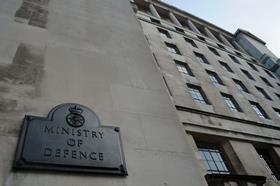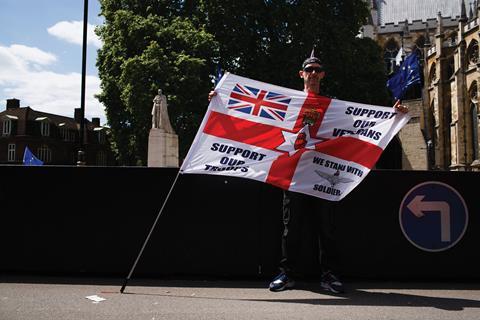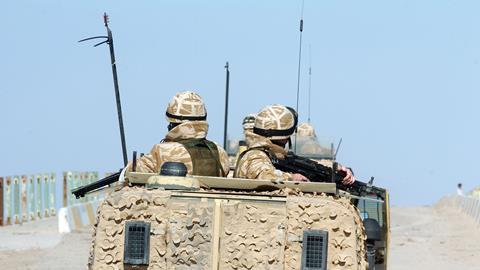When a promising military career is cut short by injury, fighting for compensation to rebuild your life can be a process fraught with obstacles. Rachel Rothwell speaks to the solicitors who act for service personnel
Earlier this month, both candidates vying to be the next prime minister signed a ‘Veteran’s Pledge’ campaigned for by the Sun newspaper.
The low down
Public pronouncements of support for veterans are an easy way for politicians to score points. But for the personal injury lawyers representing military personnel who find their careers cut short due to an injury caused by negligence, there is much that needs to be addressed on the ground: from the Ministry of Defence’s failure to learn from mistakes and avoid repeated causes of injury; to its unpragmatic approach to dealing with claims, which only serves to push up the amount it spends in legal costs. Caught in the middle is an injured serviceman or woman who has lost not just a job, but a way of life.
As well as promising to pass a law before the next general election putting a stop to ‘vexatious investigations’ into historical allegations of misconduct against servicemen and women, including in Northern Ireland, the politicians also pledged to create a new cabinet-level Office of Veterans Affairs. They would also ‘enshrine the Military Covenant into law’, so ‘the injured and bereaved are given special attention’.
The Military Covenant is a promise from the nation that those who serve in the armed forces, and their families, will be treated fairly. But while it may be politically popular to express support for our military personnel, what is the reality on the ground? Lawyers acting for men and women who have been injured while in service worry that aspects of the claims process do not live up to the wholesome rhetoric.
The Ministry of Defence is an employer like any other, and has a duty to look after the health and safety of its employees. But that is much easier to achieve when the workforce sits behind a desk, and the most dangerous item in the vicinity is the office stapler. For the MoD, the working environment is far harder to control.
After the second world war, in 1947, the government enacted the Crown Proceedings Act to prevent military personnel from suing the MoD over injuries sustained in service. But this blanket protection was stripped away in 1987, for injuries suffered after that date. Since then, it has been possible for service personnel to sue the MoD. But the ministry still has some armour plating in the form of the doctrine of ‘combat immunity’. This protects the MoD against negligence claims for incidents that occur in the heat of battle.
What precisely that includes is inevitably open to argument, but in a blow for the MoD the doctrine was given a narrow interpretation in 2013 in the landmark case of Smith and others v Ministry of Defence [2013] UKSC 41. The case concerned the use by British soldiers in Iraq of lightly armoured ‘Snatch’ Land Rovers, which did not offer enough protection to soldiers, leading to deaths. In a majority ruling, the Supreme Court held that combat immunity should not cover procurement decisions made well away from the battlefield. The doctrine also has no relevance to training exercises – a big part of military life.
‘Make no bones about it, military service is a rigorous and dangerous occupation, and the training is designed to be tough enough to prepare you to battle an enemy,’ says Grant Evatt, a former British army commando and founder of Alma Law. ‘It could involve throwing yourself out of a perfectly sound aircraft, to clearing mines from the side of a ship, to operating all types of weapons systems in the harshest of climates.’
Heavy equipment, live ammunition and strong chemicals such as degreasing agents are all part of the working environment, combined with an ethos of ‘soldiering on’ and not complaining. Training alone can involve scaling a 30-foot high assault course in helmet and webbing with 40lb of equipment on your back; or marching in extreme conditions. In 2013, three reservists died during a 16-mile SAS selection march in the Brecon Beacons in temperatures of 31C. The coroner returned a verdict of neglect and found that the three men would have survived if the hike had been stopped when other soldiers fell ill.

Damages scheme ‘doesn’t foot the bill’
The Armed Forces Compensation Scheme is a no-fault scheme that came into force on 6 April 2005 and applies to injury or illness caused by military service after that date. The scheme, which is managed by the MoD, uses a tariff system to award set amounts for different injuries. Its limitation period is more generous than for civil claims, with claimants given seven years from the date of diagnosis to make their claim, or longer in cases involving late-onset illness. Crucially, it does include injuries sustained during combat.
While lawyers recognise the benefits of such a scheme for military personnel, there are concerns. In practice, the scheme can reject claimants even where they have been discharged by the MoD on medical grounds. And the sums available fall below the levels of compensation that could be achieved through the civil courts, particularly as they do not include financial losses, such as loss of earnings, or special damages.
Simon Quinn, head of military at Hilary Meredith Solicitors, says: ‘The scheme is inadequate, as it fails to offer funding for any legal advice, so injured service personnel are often left without legal representation and are forced to navigate the complex scheme alone, and often unaware whether any offer or award made is the appropriate compensation for their level of injuries.
‘When, as frequently happens, an applicant is turned down, they are unable to navigate the appeals system. There is also no funding available for any disbursements incurred. So if an injured person needs medical evidence to support their claim, or representation from a barrister or legal representative at any oral appeal or tribunal hearing, then they usually fund these disbursements themselves.’
Simon Quinn, head of military at Hilary Meredith Solicitors, points out that despite recent advances in technology, kit and equipment, there has been a 30% rise in training injuries in the armed forces in the last four years. There were more than 3,900 such injuries in 2018. ‘MoD figures show that 23 troops were killed during training or on exercise since 2014, while around 17,400 troops have been injured in military training accidents over the same period,’ he says. ‘It’s not clear what this rise is attributable to, but there may be a correlation between budget cuts and lack of resources, or loss of senior personnel following enforced redundancies. We may also be seeing more reporting of incidents, which historically the MoD have failed to do. [But] it is an outrage that the men and women of our armed forces are not offered greater protection, and that we still regularly see many serious injuries, from often preventable accidents.’
It is an outrage that the men and women of our armed forces are not offered greater protection, and that we still regularly see many serious injuries, from often preventable accidents
Simon Quinn, Hilary Meredith
It is not just accidents that can give rise to claims from service personnel, however. In May this year in Inglis v MoD [2019] EWHC 1153 (QB), the courts awarded Alistair Inglis, a veteran of Northern Ireland and Afghanistan, more than £500,000 for noise induced hearing loss (NIHL) caused by the sound of thousands of rounds of ammunition, grenades, helicopters and explosions, to which he was exposed during his 15-year army career. His solicitor Simon Ellis, who heads the military department at Hugh James, says: ‘Alistair was a royal marine, so he was exposed to a lot of weapon fire. His criticism was that when exposed to this in combat or in training, he was not given appropriate ear protection. He ended up needing hearing aids aged 39.’
Ellis says his firm has already been contacted by ‘quite a few’ soldiers who have suffered similar problems. NIHL claims could be set to become a significant area of claim.

Alma Law’s Evatt points to another area that has become a huge source of claims: so-called ‘non-freezing cold injuries’(NFCI) – or trench foot, which has been recognised since the first world war. NFCI claims are often brought by soldiers of African or Caribbean ethnicity, who have been shown to be more vulnerable to the condition. The injuries are almost always suffered on training exercises, usually in the UK, and are linked to being put on static duties in cold weather without adequate protection.
Evatt says: ‘The problem is that mistakes are made, often repeatedly, and lessons aren’t learned. Cold injury claims are a prime example. If you have a young lad from Sierra Leone, and you stick him in the Brecon Beacons in February in the wind and the snow with the same kit as everyone else – if you don’t bring him in, he is going to get a cold injury.’
Evatt adds that even in claims where a serviceman has been ‘invalided out’ of the army for such injures, and it is clear that the MoD did not follow its own guidelines in protecting certain troops from climatic conditions, the ministry does not take a pragmatic approach to claims, which drives up legal costs.
In October last year, the MoD responded to a Freedom of Information request from Evatt, revealing that in the period from 31 August 2012 to 31 March 2017, it had settled 485 NFCI claims, paying out £26.6m in damages. None of these was defended to trial on liability, yet £24m was spent in legal and court fees in relation to them.
‘Just how many men need to lose their military careers because of these avoidable injuries? Something must be done to prevent these injuries or reduce the cost of claims, or both,’ Evatt asserts.
NFCI claims are not the only area where claimant lawyers feel the MoD could take a more sensible approach to resolving claims. Evatt says: ‘In my opinion, and I have been involved in military claims for nearly 20 years, they could and should settle many claims far sooner. It really can be a David v Goliath tussle, but it need not be. It’s becoming increasingly rare to resolve a military case without involving the courts, and as soon as you issue very expensive proceedings, if you don’t have someone on the other side who is proactive like you, the case can face extreme delay.’
Quinn echoes Evatt’s concerns. He says: ‘We tend to seek early resolution of claims, for the benefit of claimants and to save costs. For whatever reason, the MoD do seem to stretch out these claims at a significant cost to the taxpayer.
‘We see delays and disregard for the pre-action protocol, and failure to comply which means we have to make an application [to court]. Even with cases involving accidents abroad, where the time limit is six months 42 days, they still don’t comply in time. The MoD would blame understaffing, but if you can’t comply with the law, you need to get more staff. There are a lot of personnel who have been medically discharged who would be very happy to carry on doing that kind of desk job.’
Evatt acknowledges that the MoD’s stance may be designed to deter claimants from bringing claims. But he adds: ‘I still firmly believe that the MoD should at least attempt to commit to resolve claims that they know they are going to eventually settle; within an agreed timeframe, without the need for costly and time-consuming court proceedings. If they do that, then I am certain that claimants and their legal teams will be transparent, and they will collaborate with them. The MoD needs to take a leap of faith and do this. It’s the least our brave men and women deserve.’
In the military, even a relatively moderate injury can be career-ending. But any related legal claim will often be high-value, because the claimant has lost much more than just a job. As Warren Maxwell, a personal injury partner at Stewarts who served five years in the Coldstream Guards, explains: ‘People often sign up to the armed forces under the age of 20. It’s an opportunity to make lifelong friends, and be part of a supportive close-knit community. You receive accommodation. You have a long-term career, with opportunities for advancement and to try different roles. To lose that because of an accident that was the employer’s fault can be devastating.’
Claims will not only involve loss of benefits such as a generous pension, accommodation, and various allowances and perks. There is also the question of how long the individual would have stayed in the forces. A young recruit with a good performance record on deployment, or a soldier with family members who have had long army careers, could argue that they themselves would have served for many years. Then there is the issue of what second career they might have gone on to enjoy. Without the negligence, would they have reached a more senior army rank, and so entered the civilian workforce at management level, with a double pension? When it comes to calculating damages, the courts tend to be more willing than usual to accept the use of employment experts, because of the complexity involved.
It is difficult for any employee to sue their employer while they are still working for them, but in the armed forces this is even more of an issue. ‘There’s a culture of, “it’s a dangerous job – get used to it”,’ explains Maxwell. ‘And there is a perceived chance of discrimination or lack of promotion if you do bring a claim.’
The three-year limitation period for bringing a claim is a common barrier to legal action. Quinn says: ‘We often speak with service personnel who were misinformed by the MoD on limitation, and/or their ability to bring a claim. Many injured service personnel are told that they are unable to bring any civil claim until they leave the armed forces, which can result in them missing limitation and being precluded from bringing any civil claim.’ Once the time limit has passed, it is simply too late.
For service personnel who find their military career ending abruptly due to injury, adjusting to life on Civvy Street can be difficult. Evatt understands this more than most. He joined the army straight from school at 16 and went on to spend a decade as a commando, with skillsets including Arctic and jungle warfare, parachuting, diving and skiing. But a sports injury forced him to end his army career ahead of time.
‘You join the military to serve, to belong, to be part of something. You make lifelong friends, your entire family commits to a life of service and, sadly, many make the ultimate sacrifice,’ he says. ‘Our military is the envy of the world. We really do have the best of the best. I miss that life and I miss those I served with. Military service is not just a job. It’s a way of life.’
1987 - The year service personnel were able to sue the MoD over injuries sustained in service
17,400 - Number of troops injured in military training accidents since 2014
485 - Number of NFCI claims settled by the MoD between 2012 and 2017
Rachel Rothwell is a journalist
































No comments yet